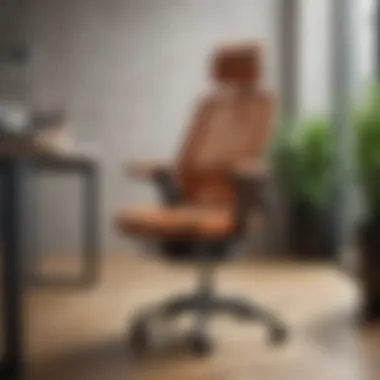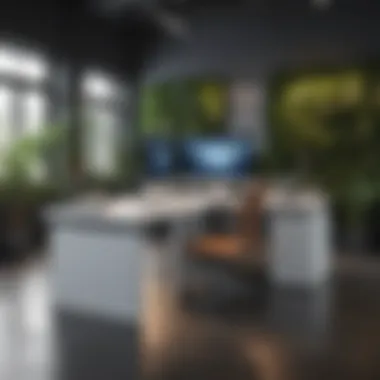Innovative Approaches in Office Furniture Design


Intro
In recent years, the field of office furniture design has undergone a notable transformation. The shift towards more dynamic and adaptive workspaces highlights the significance of innovative approaches in design. This evolution is not merely aesthetic; it is influenced by the changing ways we work and the recognition of comfort and efficiency as priorities. Office furniture is now a key component in shaping both productivity and employee well-being, echoing the broad trends of flexibility, ergonomics, and sustainability.
Understanding Modern Workspace Needs
The design of office furniture directly reflects shifts in how we work. Understanding modern workspace needs is essential for creating environments that foster productivity and well-being. This section highlights key elements that should be considered in design, helping to inform furniture manufacturers and designers.
The Shift Towards Flexible Workspaces
Flexible workspaces are taking center stage in modern office environments. This shift accommodates varied working styles, allowing employees to change their work settings throughout the day. Companies like WeWork promote shared office spaces that cater to collaboration and individual tasks alike. Key considerations include:
- Adaptable configurations: Furniture that can be easily re-arranged encourages spontaneity and creativity.
- Multi-functional pieces: Desks with integrated storage or collaborative furniture can maximize limited spaces.
The ability to transform a workspace as needed enhances employee satisfaction and boosts productivity.
The Impact of Remote Work on Design Trends
Remote work has led to a significant change in office furniture design trends. As employees now often work from home, the demand for ergonomic and stylish home office solutions has surged. Designers must now consider:
- Space optimization: Many individuals work in small areas, so compact and efficient designs are crucial.
- Aesthetic value: Home offices should be visually appealing. This encourages a positive mindset and professionalism during video calls.
The trend reinforces the idea that an employee’s environment directly impacts efficiency and morale.
Prioritizing Employee Well-Being
Workspaces must prioritize employee well-being to create a positive atmosphere. This involves:
- Ergonomic furniture: Chairs and desks that provide adequate support help prevent discomfort and long-term health issues.
- Natural light and ventilation: Designs that incorporate these elements result in better overall employee satisfaction.
By focusing on these aspects, companies can foster a healthier, more engaged workforce.
"Prioritizing well-being in workspace design not only enhances productivity but also elevates the overall employee experience."
Trends in Office Furniture Design
The office furniture design landscape is in a constant state of evolution, shaped by various factors including functionality, aesthetic appeal, and the needs of users. Trends within this domain not only reflect changing tastes but also adapt to the evolving ways people work. Understanding these trends is essential for manufacturers and designers who aim to create environments that are productive and appealing.
Sustainable Materials and Practices
One of the most significant movements in office furniture design is the emphasis on sustainability. Manufacturers are increasingly prioritizing eco-friendly materials and practices. This shift is driven by heightened awareness of environmental issues and consumer preferences for products that are not only stylish but also sustainable.
Materials such as bamboo, recycled metals, and reclaimed wood are gaining popularity. They offer aesthetic appeal while also minimizing the carbon footprint. Additionally, practices such as responsible sourcing and waste reduction in production processes play a crucial role in creating sustainable office furniture.
Companies that incorporate these materials often find a competitive edge. Customers, especially those in urban settings, seek furniture that aligns with their values. This move towards sustainability can enhance brand loyalty and attract environmentally conscious consumers.
Ergonomics: Designing for Comfort


In today's work culture, the importance of ergonomics cannot be overstated. Ergonomic furniture design focuses on adapting workspaces to fit the needs of users, promoting comfort and reducing the risk of injury. The rise of remote and flexible work arrangements makes this even more relevant, as employees are working in diverse settings, from home offices to shared spaces.
Ergonomic chairs and desks designed with user comfort in mind not only improve the overall experience but also boost productivity. Features such as adjustable height, lumbar support, and armrests are critical elements in promoting better posture and reducing fatigue.
Many office furniture companies are investing in research that supports ergonomic principles, leading to truly innovative designs. Creating products that address the physical demands of work is essential in the modern landscape, where health and efficiency are paramount.
The Role of Technology in Office Furniture
Technology is significantly influencing office furniture design. As workplaces evolve, integrating technology into furniture solutions is becoming increasingly necessary. This integration includes smart desks that offer adjustable heights, built-in charging ports, and even wireless charging surfaces. Such innovations enhance functionality without compromising aesthetics.
Furthermore, technology facilitates better collaboration. Modular furniture that can easily be reconfigured allows teams to adapt to different project dynamics. This flexibility meets the changing needs of teams, particularly in environments where collaboration is key.
Smart office solutions are likely to grow in popularity. Incorporating things such as sensors for monitoring air quality or lighting can provide insights into workplace conditions. These technological advancements are not only making workspaces more efficient but also more comfortable and tailored to individual needs.
"As office designs transition into the future, the synergy of ergonomics, sustainability, and technology will define new standards in workspace efficiency and employee well-being."
In summary, keeping an eye on the latest trends in office furniture design is crucial. By focusing on sustainability, ergonomics, and technology, companies can significantly enhance user experience and workplace functionality. This strategic approach to office furniture design ensures that businesses remain relevant and competitive in a rapidly changing market.
Creative Ideas for Office Furniture Companies
In today's competitive market, it is essential for office furniture companies to develop creative ideas that align with modern workspace needs. This thematic approach not only boosts functionality but also enhances user experience. Creative designs can lead to better employee satisfaction and productivity. Adapting to trends helps companies stay relevant and appealing to clients who seek innovative solutions. Here, we delve into noteworthy strategies that emphasize versatility, the integration of nature, and technology.
Modular Designs for Versatility
Modular designs represent a vital shift in office furniture philosophy. They are not just about aesthetics but function significantly. This type of design allows for easy reconfiguration, enabling spaces to adapt quickly to different tasks or team sizes. For instance, office layouts can be changed within minutes to transition from collaboration to focused work.
- Enhanced Flexibility: Modular systems can accommodate growth and change in workforce dynamics. Companies can save costs in the long run by investing in furniture that continues to meet evolving demands.
- Customizable Solutions: Modular pieces can be tailored to specific needs. This includes various configurations and finishes that resonate with the company’s branding.
The ability to create zones within a workspace can lead to improved communication and collaboration among teams. Thus, embracing modular design contributes to a more dynamic and responsive work environment.
Biophilic Design Principles
Incorporating biophilic elements into office furniture design aligns with the growing awareness of the natural world's impact on well-being. This principle focuses on integrating nature into workspaces to foster a sense of connection. Biophilia is crucial for enhancing mood and productivity.
- Natural Materials: Using sustainable materials such as bamboo or reclaimed wood not only reduces environmental impact but also adds warmth to spaces.
- Integration of Greenery: Furniture designs that allow for integrated planters or easy placement of plants can transform the atmosphere, making it more inviting.
Ultimately, biophilic design principles become a conduit for not just beautifying a workspace but improving cognitive function and emotional well-being. Companies adopting these principles will likely experience the benefits of a happier, more engaged workforce.
Integrating Technology into Furniture Solutions
The infusion of technology in furniture design defines future workplaces. Smart solutions can simplify tasks and enhance user comfort. The demand for technology-driven solutions is growing rapidly among employees and employers alike.
- Wireless Charging Stations: Office desks can be equipped with built-in charging ports that allow for effortless connectivity, minimizing clutter and optimizing functionality.
- Adjustable Features: Implementing technology such as automated height adjustments for desks caters to ergonomics, allowing users to alternate between sitting and standing throughout the day.
Integrating technology into office furniture moves beyond trends; it signifies a commitment to improving efficiency and functionality. The modern workforce can greatly benefit from such innovations.
"Embracing creative ideas in office furniture design is not merely a trend; it is a prerequisite for fostering an adaptable and productive work culture."
In summary, office furniture manufacturers must embrace modular designs, biophilic principles, and technology integration. These approaches not only address practical concerns but also resonate with the broader aim of enhancing workplace well-being and productivity.


Case Studies of Innovative Office Designs
Understanding practical examples of innovative office designs is crucial. Case studies highlight how specific companies have navigated the challenges of modern workplace requirements. They illustrate the application of emerging trends such as sustainability, ergonomics, and the incorporation of technology into furniture solutions. These examples serve as a reliable source for office furniture companies by showcasing effective strategies and practical implementations.
Tech Companies Leading the Way
Tech companies are often the pioneers in adopting advanced office designs. By embracing open floor plans and allowing for flexible workspaces, these organizations facilitate collaboration. For example, Google's headquarters reflects this trend. Their use of movable furniture and spaces designed for both quiet work and teamwork supports productivity. This setup allows employees to choose environments that suit their specific tasks, fostering creativity and focus.
Moreover, tech companies often prioritize sustainable materials. Facebook's use of recycled materials in its offices showcases a commitment to environmental responsibility. This is increasingly important for companies aiming to align with modern values regarding sustainability and ethical practices.
Start-ups Embracing Unconventional Layouts
Start-ups continue to challenge traditional office layouts. Many embrace a non-linear approach to design, opting for more relaxed atmospheres. A notable example is WeWork, which uses shared spaces and communal areas to encourage interaction. This model promotes a sense of community among different teams and businesses.
Moreover, the design of such spaces allows flexible arrangements. This is essential for start-ups, where team sizes and collaboration needs can change rapidly. Modular furniture is frequently used in these environments, enabling easy reconfiguration to suit various group sizes and activities.
Corporate Giants Redefining Workspaces
Large corporations are also rethinking their office designs in response to changing workplace dynamics. For instance, companies like Deloitte are integrating wellness elements into their work environments. Their offices include areas for relaxation and social interaction, which help reduce stress and improve employee well-being.
Additionally, these corporate giants leverage technology to enhance functionality. Smart furniture solutions are designed to incorporate charging stations and adjustable height desks. Such innovations support the diverse work styles of employees and promote better health and productivity.
Effective office designs not only enhance aesthetics but also contribute directly to employee satisfaction and overall productivity.
Designing for Collaboration
Collaboration is essential in the modern workplace. When we talk about designing for collaboration, we need to understand the elements that promote teamwork and communication. A well-designed office encourages interaction among colleagues. It transforms static settings into dynamic spaces where ideas flow freely. By focusing on collaborative design, companies can enhance not only productivity but also employee satisfaction.
Creating Collaborative Spaces
Creating collaborative spaces goes beyond just layout. It is about creating an environment that feels open and inviting. Considerations in design include natural light, color schemes, and sound control, all of which impact the mood of the workspace. Spaces can be designed for both large group discussions and small teams. This flexibility is vital in accommodating various styles of teamwork.
- Open Areas: These promote spontaneous interactions. Open layouts can reduce barriers between teams.
- Meeting Zones: Equipped with technology, these zones can host formal meetings or brainstorming sessions.
- Casual Interaction Points: Spaces like lounges can encourage informal discussions, often leading to innovative ideas.
"In collaborative environments, workspace design significantly influences how teams function and interact."
Furniture Solutions for Team Work
Furniture plays a pivotal role in facilitating collaboration. The right choice can either hinder or promote teamwork. Here are some important aspects to consider:
- Adaptable Seating: Chairs and tables that can be reconfigured easily support changing group sizes.
- Tech-Integrated Furniture: Desks with built-in charging stations help teams stay connected and productive.
- Privacy Features: Sometimes, team work requires focused discussions. Having furniture that provides privacy can balance collaborative and individual work.
Ultimately, innovative furniture solutions foster a collaborative culture. By prioritizing these aspects in office designs, organizations can develop workspace that not only meets the functional needs but also enhances overall employee engagement.
Navigating the Challenges of Office Furniture Design
In today’s rapidly changing work environments, the design of office furniture presents unique challenges. Companies must consider not only the aesthetics of the furniture but also the functional aspects that contribute to a more effective workspace. This section addresses the critical challenges of office furniture design, highlighting the balance required between various demands. Successful navigation of these challenges can lead to enhanced productivity, employee satisfaction, and improved adaptability of workspaces.
Balancing Aesthetics and Functionality


Striking the right balance between aesthetics and functionality is essential. Aesthetic appeal attracts clients and makes workplaces inviting. However, it must not compromise usability. For instance, while a sleek desk might enhance the look of an office, if it lacks essential features like adequate storage, it may frustrate employees.
Consider these points:
- Modern designs often emphasize minimalist approaches. This can lead to greater visual coherence but might limit practicality.
- Ergonomics must guide the design process. The importance of adjustable desks and supportive seating cannot be overstated for long-term health and productivity.
- Sustainability and materials choice also influence both appearance and usability. For example, reclaimed wood can provide distinct aesthetics while being functional and environmentally friendly.
The challenge, therefore, is to create furniture that is not only visually appealing but also equipped to serve diverse work functions efficiently.
Addressing Space Limitations
Urban environments present significant space limitations that influence office furniture design. The need for compact, efficient solutions is paramount for businesses in crowded areas. Addressing these challenges requires innovative thinking in design and layout.
Some strategies include:
- Modular furniture systems that can be easily adapted to different space configurations. These allow for customized setups that can change according to group size or project requirements.
- Employing multi-functional pieces, such as a coffee table that doubles as storage. This strategy maximizes limited space while providing necessary functionality.
- Implementing vertical space solutions. Wall-mounted desks and shelving can utilize previously unused areas, freeing up floor space for movement and collaboration.
Navigating spatial constraints involves creativity and acknowledgment of the nuances of each workspace. Effective office furniture designs must accommodate the spatial challenges faced by many companies while still promoting collaboration and productivity.
"The future of office design hinges upon our ability to innovate in the face of limitations."
Future Directions in Office Furniture Design
The exploration of future directions in office furniture design is essential for understanding how workplaces will adapt to changing needs and expectations. As businesses respond to shifts in work culture, emphasis is placed on adaptability, sustainability, and user-centric solutions. Recognizing emerging trends and possible technologies will help furniture companies craft designs that enhance productivity and well-being.
Emerging Technologies and Their Implications
Technological advancements are influencing office furniture design in multiple ways. These innovations promise to enhance functionality and improve the overall user experience. Here are a few significant aspects:
- Smart Desks and Chairs: Integrating sensors and connectivity features allows furniture to collect data on user habits. This data can be leveraged to adjust settings for optimal comfort and efficiency.
- Augmented Reality (AR): As users explore potential office layouts or furniture options, AR tools enable them to visualize changes in real-time. This technology can also assist in the customization of designs according to specific needs.
- Sustainable Materials: Developments in materials science are leading to eco-friendly options. These advancements can contribute to a reduction in environmental impact while maintaining aesthetic quality and durability.
"Technology not only facilitates greater connectivity in the workplace but also transforms the physical space into a more responsive and adaptable environment."
Trends to Watch in Workspace Design
Keeping an eye on evolving trends is crucial for companies aiming to stay relevant. Several key trends are emerging that will shape the future of workspace design:
- Wellness-Centric Spaces: There is a shift toward creating environments that prioritize employee wellness. This trend includes incorporating features like biophilic design and adaptable work areas.
- Collaborative Configurations: Open-plan designs and co-working spaces are gaining popularity. These setups encourage interaction while allowing for flexibility in how teams work together.
- Personalization in Design: Employees bring individual preferences to their workspace. Furniture solutions that allow for customization can help accommodate diverse needs.
- Remote Work Considerations: As remote work continues to influence the office setup, designers need to create furniture that supports both on-site and home office functionality.
- Technological Integration: Furniture that supports advanced technology fosters a seamless working experience. Solutions that allow for easy cable management and docking stations are essential.
In summary, future directions in office furniture design are tied closely to technological advancements and shifting workplace dynamics. Keeping up with these trends will enable furniture designers to create products that not only meet current demands but also anticipate future needs.
The End
Importance of Innovative Design
Innovative design is about more than aesthetics; it considers functionality, comfort, and adaptability. As workplaces evolve, the need for designs that accommodate various working styles and preferences has become paramount. Employers are increasingly recognizing that well-designed workspaces enhance productivity and employee satisfaction.
Key Elements to Consider
- Flexibility: Furniture should allow users to adapt their spaces according to their needs. Modular and movable pieces can facilitate a range of activities, from solitary tasks to collaborative projects.
- Ergonomics: Proper design prioritizes human comfort. Ergonomic furniture helps in reducing strain, leading to healthier work conditions.
- Sustainability: Using eco-friendly materials and processes not only benefits the environment but also attracts consumers who value corporate responsibility.
- Technology Integration: As technology advances, incorporating tech into furniture, like integrated charging stations or smart desks, is also a significant trend. This adds convenience and enhances the functionality of the workspace.
Benefits of Adopting Innovative Approaches
Incorporating innovative office furniture design can lead to various advantages:
- Improved employee productivity due to better comfort and flexibility
- Enhanced workplace aesthetics, which can positively influence company branding
- Greater employee retention as workplaces that prioritize wellbeing often see lower turnover



